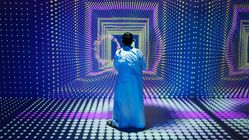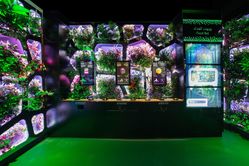In the Dubai of 2050, the world looks both instantly familiar and utterly strange. Here, urban planning is driven by an omniscient AI installed at the top of a skyscraper; your smart bathroom mirror tracks your physical health; and you interface with the government through a personalized “genie,” a hologram in the form of a virtual Emirati gentleman in traditional garb.
This is the work of the design-futures agency Tellart—specifically, their giant-scale installation at United Arab Emirates’ annual government summit. They call it the Museum of Future Government Services. The job is to construct a working, immersive prototype of a possible future.

Chayka categorizes Tellart’s work as design fiction, but that dramatically understates the scale and ambition of work like the Dubai project. The installation is an almost-nostalgic return to the spirit of the last century’s World’s Fairs.
Over the past couple of years, I’ve had occasional conversations with Paul Skinner and Christian Ervin, two of the designers of the project. I’ve been impressed by both the POV of the project and the academic rigor with which its trends are explored. (Check out Christian’s 2017 talk from Interaction and Paul’s 2015 talk from push.conference—both about this project. Seriously, gentlemen, when do we get to work together?)
It turns out the Museum of Future Government Services is a bonafide UX research study, albeit pumped up on steroids. Its exhibits are not the answer to how the future might look, but the opening question.
Tellart proposes that perhaps the best way to test out future paths is to go ahead and build them—and see what happens. Rather than being prescriptive of how things should be, they basically create a life-size usability lab to test what happens for things that might be. How do government officials respond to them? How do citizens? They lay out possible threads to the future and then tug on them.
Some of the ideas are delightful, others creepy, some downright horrifying. There’s a sense of humor throughout. The goal is to find a path that dances what turns out to be a surprisingly fine line between dystopia and utopia.
“Is this is a world where collapse happened, or a world where transformation happened, or growth?” [Tellart co-founder Matt Cottam] asks. Clients might pose a product or a problem, but Tellart brings in teams of outside consultants, from architects to futurists and sci-fi novelists, for world-building and selecting a relevant situation to simulate. You’re dealing with a robo-nurse at the emergency room of an automated hospital, say, or your self-driving car is running late to work and has to dodge traffic. Finally there’s the physical stuff, the kitsch and junk of the future that make the theoretical world realistic and give visitors cues on how to behave in it. Every detail must be considered.

As a design industry, we need more exploration like this at scales both large and small. We tend to plunge ahead without testing the waters. Few designers have the opportunity to tinker with prototypes at this scale, but all of us can do smaller versions in our own research practice. In my own work I try to build lots of little “what if” prototypes to gauge response, utility, and cultural impact. Splashing in puddles helps us test whether our ideas will tip into the utopian or dystopian side of the line.
In its client work, Tellart has effectively found patrons to fund its exploration of the future at grand scale. Doing this kind of work for clients, of course, necessarily changes the outcome. And there are always ethical decisions in the clients you choose. The UAE has a rough record on human rights, and it’s not exactly the world’s most democratic society. Chayka’s piece explores this effectively.
Then again, Tellart influenced the client—a country whose entire economy is based on oil proceeds—to take on climate change as its focus this year, though Chayka is skeptical that it has much bite. “In this future, the money from oil has solved all the problems that oil dependency creates — thanks to technology, the desert becomes a permanent oasis. Tellart’s work reassures its viewers that the environment is an issue that will simply be fixed one day, through no effort on their part.”
Tellart’s worldview, though, is that if you can at least suggest it will be fixed, we make actually find the steel to fix it:
The 2017 exhibition was a “reframing of climate change so it’s not seen as something that we can’t get control of, that’s beyond our capabilities,” Scappaticci says. “Here’s a version of our future in which we’ve come together, we’ve solved these problems, and we’re more in harmony with the world,” presenting the possibility of a solution so we don’t have to, say, give up and move to Mars. Tellart’s boutique futurism is ultimately an optimistic one, motivated by a belief that, with funding from its clients, we can tweak the incipient future simply by envisioning it.
Are you sorting out what the future looks like for your organization? Big Medium does ideation workshops and executive sessions to help companies figure out what’s next. Get in touch.





